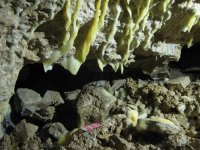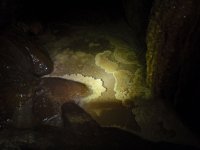You are using an out of date browser. It may not display this or other websites correctly.
You should upgrade or use an alternative browser.
You should upgrade or use an alternative browser.
Yellow calcite
- Thread starter Joe Duxbury
- Start date
Babyhagrid
Well-known member
is it sulphur? i vaguely remember that being yellow.
Speleofish
Active member
presumably not the same as yellow snow...
Pete K
Well-known member
I was once told that under farmland, uric acid could leach in and lead to a pale yellow colour in cave formations. I don't know how accurate that is, but it's a good one to tell kids on caving trips. There are probably numerous minerals it could be though, depending on the local geology. Where are these formations?
Jim MacPherson
Active member
Presumably these things are called zappatites or maybe frankmites?I was once told that under farmland, uric acid could leach in and lead to a pale yellow colour in cave formations. I don't know how accurate that is, but it's a good one to tell kids on caving trips. There are probably numerous minerals it could be though, depending on the local geology. Where are these formations?
cap n chris
Well-known member
Don't overlook the role of humic acid and fulvic acid which arise from water percolating through humic layers on the surface; fulvic acid is yellow in colour; the organic acids usually get sidelined when dealing with cave formations because organic chemistry is kinda A-Level rather than Key Stage 3 Earth Sciences, which is probably why the carbon cycle (carbonic acid/calcium carbonate) usually gets top billing 'cos it's waaay easier to get your head around. IIRC the organic acids are orders of magnitude more aggressive (and hence significantly relevant in cave settings) than carbonic acid.
tim.rose2
Active member
I've always been led to believe yellows / oranges / reds are due to varying amounts (concentrations) of iron / differing iron based minerals (i.e. the counter ion) in the soil / rock. I'm no expert on the matter but it sounds plausible to me. Most of the flowstone / calcite on Portland is coloured. Poor photo, but this wall (in Windy Dig) shows the full range of colours nicely. There's only 5 to 10 m of 'ground' above this and the soil layer is pretty thin. No running water, just rain percolating through from the surface making things a bit drippy. The cave is mostly under the footpath / cliff edge and may extend under field beyond so unlikely to be any unnatural influences.

Joe Duxbury
Active member
Yes, these are also under farmland, in a disused Cotswold underground stone quarry. We joked that this was crystallised sheep's piss, but it's arable land above. And like Tim Rose's Portland caves, "There's only 5 to 10 m of 'ground' above this and the soil layer is pretty thin."I was once told that under farmland, uric acid could leach in and lead to a pale yellow colour in cave formations. There are probably numerous minerals it could be though, depending on the local geology. Where are these formations?
So, uric acid or iron?
tim.rose2
Active member
Not sure I like the uric acid explanation for the coloured flowstone on Portland. There's plenty of coloured flowstone including places like in caves under old building or quarries from several hundred years ago (i.e. highly unlikely to have been farmed / had farm animals on it). Compared to other areas (e.g. Mendips / Dales) Portland has seen very little in the way of farm animals. On Portland I would favour an explanation which could explain higher than 'normal' concentrations of iron rather than uric acid in the soils above the limestone.
Shale - that's more interesting. The Portland limestone sits on shale which is exposed along the shoreline. It's therefore perfectly reasonable to expect the sea along the coast to contain bits / particles of shale due to erosion. In a decent storm you get a thorough 'salting' stood on top the cliffs even 70 to 100 m above sea level. In fact in a good storm everything (cars particularly noticeable) gets covered in a layer of 'sea salt'. I think it perfectly reasonable to conclude that the 'salt' could contain macroscopic / microscopic shales as it's simply from the spray whipped up by the wind / waves along the shoreline (i.e. this provides a mechanism of transport for the shale from below the limestone to above). Over geological time scales it's therefore plausible that the soil layer on Portland could contain small particles (high surface area) of shales. I don't know a lot about the make up of sedimentary rocks and I'm sure others can better comment than me but wiki suggests shale is typical 2% iron oxides, whereas limestone 'may contain traces of iron compounds' (i.e. much less). So if there are high surface area shales in the soil, dissolution of this material in rain water could result in iron rich water dripping down into the caves. Having tried to grow vege in the bloody stuff I know that the soil on Portland is alkaline, very claggy (clay like), and holds water so I'd imagine the permeation time from surface to cave is fairly significant giving plenty of opportunity for dissolution of the iron compounds despite the lack of soil depth. Again I'm no expert on the matter but I don't think sea salt normally contains any significant quantities of iron so alone it's not likely to be the cause of the colour.
The other significant feature of the coloured flowstone on Portland is that it can easily be 4 inches (or more) thick and coloured right through (i.e. not simply surface colouring). I've no idea how quick the flowstone grows but at 4 inches thick it feels more like geological time scales than 'consequences of humans' time scales.
Happy to be corrected by more knowledgeable people and my arguments above picked to pieces, this is just my musings on the matter!
In the meantime another photo or two:
The 'dehydrated piss stal.' first seen by human eyes about 18 months ago...

Harpic grotto in Persil Rift:

Shale - that's more interesting. The Portland limestone sits on shale which is exposed along the shoreline. It's therefore perfectly reasonable to expect the sea along the coast to contain bits / particles of shale due to erosion. In a decent storm you get a thorough 'salting' stood on top the cliffs even 70 to 100 m above sea level. In fact in a good storm everything (cars particularly noticeable) gets covered in a layer of 'sea salt'. I think it perfectly reasonable to conclude that the 'salt' could contain macroscopic / microscopic shales as it's simply from the spray whipped up by the wind / waves along the shoreline (i.e. this provides a mechanism of transport for the shale from below the limestone to above). Over geological time scales it's therefore plausible that the soil layer on Portland could contain small particles (high surface area) of shales. I don't know a lot about the make up of sedimentary rocks and I'm sure others can better comment than me but wiki suggests shale is typical 2% iron oxides, whereas limestone 'may contain traces of iron compounds' (i.e. much less). So if there are high surface area shales in the soil, dissolution of this material in rain water could result in iron rich water dripping down into the caves. Having tried to grow vege in the bloody stuff I know that the soil on Portland is alkaline, very claggy (clay like), and holds water so I'd imagine the permeation time from surface to cave is fairly significant giving plenty of opportunity for dissolution of the iron compounds despite the lack of soil depth. Again I'm no expert on the matter but I don't think sea salt normally contains any significant quantities of iron so alone it's not likely to be the cause of the colour.
The other significant feature of the coloured flowstone on Portland is that it can easily be 4 inches (or more) thick and coloured right through (i.e. not simply surface colouring). I've no idea how quick the flowstone grows but at 4 inches thick it feels more like geological time scales than 'consequences of humans' time scales.
Happy to be corrected by more knowledgeable people and my arguments above picked to pieces, this is just my musings on the matter!
In the meantime another photo or two:
The 'dehydrated piss stal.' first seen by human eyes about 18 months ago...
Harpic grotto in Persil Rift:





